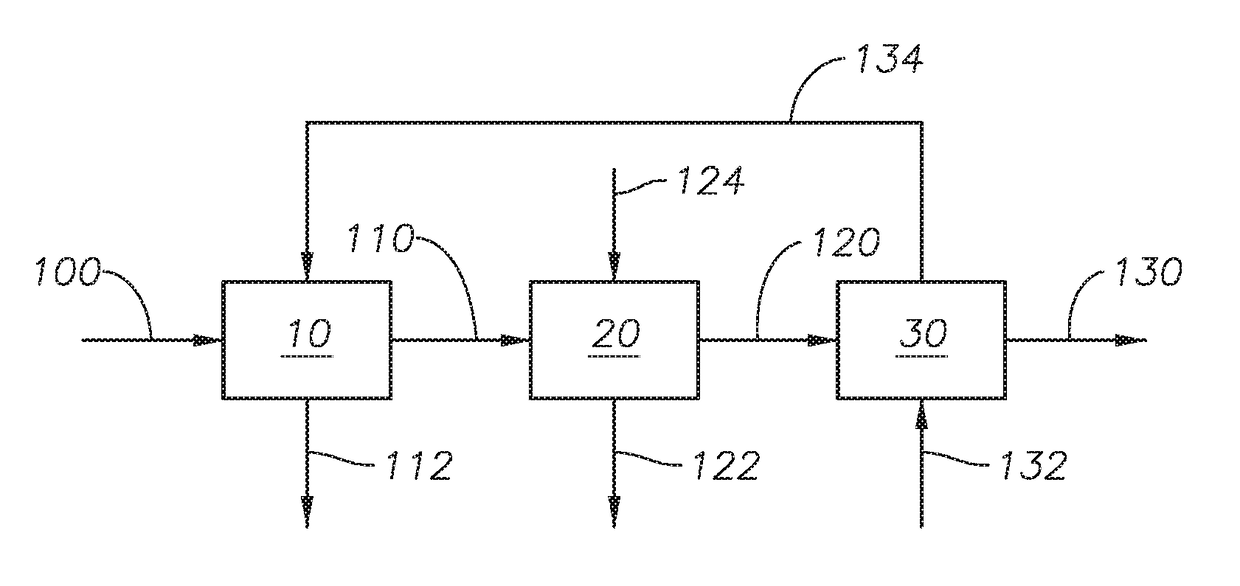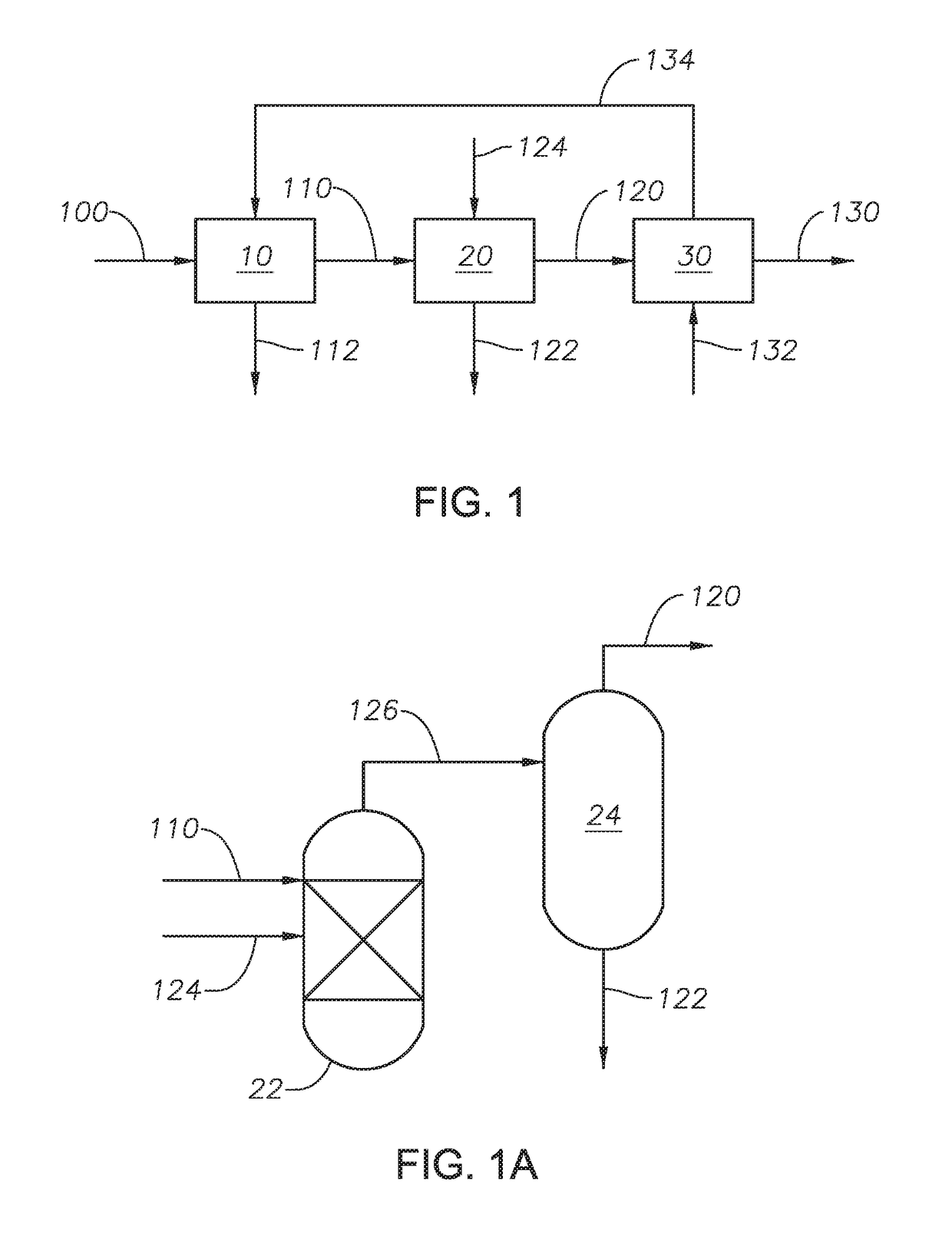Enhancement of claus tail gas treatment with membrane and reducing step
a technology of claus tail gas treatment and membrane, which is applied in the direction of sulfur preparation/purification, hydrogen sulfide, and separation processes, etc., can solve the problems of significant capital cost to the claus treatment unit, catalyst bed plugging or deactivating, and reaction furnaces that can destroy contaminants such as hydrocarbons, and achieve the effect of minimizing sulfur dioxide emissions and improving sulfur recovery
- Summary
- Abstract
- Description
- Claims
- Application Information
AI Technical Summary
Benefits of technology
Problems solved by technology
Method used
Image
Examples
example 1
[0095]Example 1 was simulated based on the configuration embodied in FIG. 14, with reference to FIG. 2 as described and is a comparative example. The sulfur recovery unit is operated in split mode due to the low hydrogen sulfide content in acid gas feed 100. The simulation contained no membranes and no reducing unit. The simulation was based on catalytic unit 16 having three Claus catalytic stages in series. The reaction furnace outlet Claus process with three Claus catalytic stages in series. The reaction furnace temperature outlet was 2097° F. (1147° C.). The resulting concentrations of components for selected streams are shown in Table 2.
[0096]
TABLE 3Heat and Mass Balance of Streams for Example 1.Stream100300212224226110112C10.00280.00000.00000.00000.00000.00110.0000C20.00140.00000.00000.00000.00000.00060.0000CO20.69150.00000.28680.00040.00040.47210.0000H2S0.22760.00000.00260.00030.00010.00570.0000N20.00000.79210.48620.00000.00000.31630.0000H2O0.07620.00990.13420.02290.07050.1972...
example 2
[0098]Example 2 was simulated based on the configuration embodied in FIG. 2 and described above. Sulfur recovery unit 10 is operated in split mode due to the low H2S content in acid gas feed 100. The simulation was based on catalytic unit 16 having three Claus catalytic stages. The reaction furnace temperature outlet was 1838.9° F. (1004° C.). The permeate of hydrogen sulfide membrane 30 was swept with air in sweep air feed 132. The membrane in hydrogen sulfide membrane 30 was a hydrogen sulfide-selective membrane area with the permeability specified in Table 2 and with a total area of 61,642 square meters (m2). The pressure of membrane feed 120 was 16 psig (280.6 kPa). The permeate pressure was set at −7 psig (53.1 kPa). The resulting concentrations of components for selected streams are shown in Table 4.
[0099]
TABLE 4Heat and Mass Balance of Streams for Example 2.Stream100132212224226120134112130C10.00280.00000.00000.00000.00000.00120.00010.00000.0013C20.00140.00000.00000.00000.000...
example 3
[0101]Example 3 was simulated based on the configuration embodied in FIG. 3. Sulfur recovery unit 10 is operated in split mode due to the low H2S content in acid gas feed 100. The simulation was based on catalytic unit 16 having three Claus catalytic stages. The reaction furnace temperature outlet was 1492.3° F. (811.4° C.). The membrane in hydrogen sulfide membrane 30 was a hydrogen sulfide-selective membrane area with the permeability specified in Table 2 and with a total area of 61,642 m2. The pressure of membrane feed 120 was 75 psig (618 kPa). The permeate pressure was set at 1 psig (108 kPa). The resulting concentrations of components for selected streams are shown in Table 5.
[0102]
TABLE 5Heat and Mass Balance of Streams for Example 3.Stream100300212224226120134112130C10.00280.00000.00000.00000.00000.00100.00030.00000.0012C20.00140.00000.00000.00000.00000.00050.00020.00000.0005CO20.69150.00000.45190.00040.00050.62600.35630.00000.5768H2S0.22760.00000.00170.00030.00010.00810.008...
PUM
| Property | Measurement | Unit |
|---|---|---|
| temperature | aaaaa | aaaaa |
| pressure | aaaaa | aaaaa |
| pressure | aaaaa | aaaaa |
Abstract
Description
Claims
Application Information
 Login to View More
Login to View More - R&D
- Intellectual Property
- Life Sciences
- Materials
- Tech Scout
- Unparalleled Data Quality
- Higher Quality Content
- 60% Fewer Hallucinations
Browse by: Latest US Patents, China's latest patents, Technical Efficacy Thesaurus, Application Domain, Technology Topic, Popular Technical Reports.
© 2025 PatSnap. All rights reserved.Legal|Privacy policy|Modern Slavery Act Transparency Statement|Sitemap|About US| Contact US: help@patsnap.com



